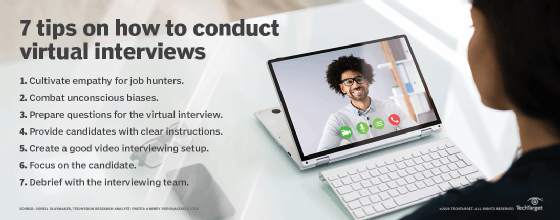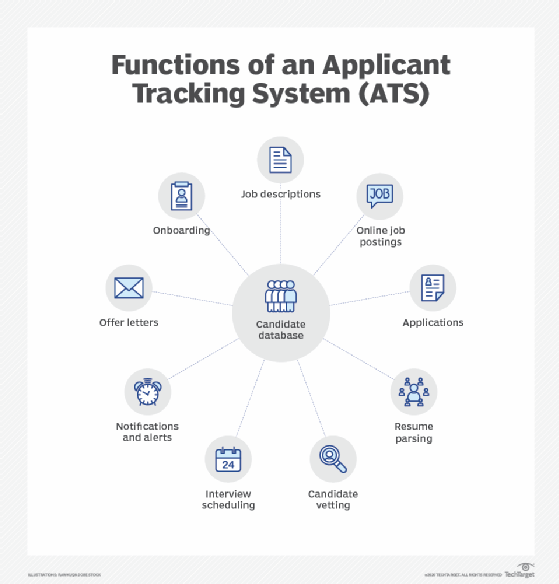
rocketclips - stock.adobe.com
12 tips for recruiting and hiring ideal remote employees
The pandemic has made working remotely the new normal in many organizations. Here's how to find and hire the best candidates -- all with a new, more virtual recruiting process.
HR is learning and adapting on the fly now that remote workers are the base of the workforce rather than far-flung outliers. That pandemic-fueled flip in the employment model continues to put new pressures on old processes. Organizations must make it a priority to learn how to hire remote employees.
The challenges are not expected to ease anytime soon. According to a new study, "HR in the Age of Workplace Uncertainty," by MindEdge and HRCI, 88% of responding companies were hiring during the pandemic, although nearly half (43%) were doing so at a reduced rate.
Crafting a strategy to hook new recruits from afar is an ongoing challenge. It's a two-pronged problem: Organizations are having to learn new ways to complete the recruitment process remotely at the same time that they have to adapt to cultural and organizational changes from having a mostly remote workforce, which includes giving more scrutiny to what makes a good remote worker.
The study noted that HR professionals "expressed significant reservations about remote recruiting processes," with 35% reporting that remote recruiting is harder than in-person recruiting. Of the remaining respondents, 18% said remote recruiting is easier, while 34% felt there was little to no difference.
Awkwardness and technical problems are common issues in the remote recruiting and hiring process, said Andrew Lynch, a recruitment expert and director at Teaching Abroad Direct, a job board in the U.K. for teachers looking to work abroad.
"Recruiters should make some allowance for candidate nervousness and uncertainty during the interview, given that many candidates feel awkward when talking remotely. There are fewer opportunities to build physical rapport and delays in internet connection may interrupt the flow of conversation," Lynch said.
Employee retention problems born from the uniqueness of the times make successful recruitment efforts even more imperative. According to the MindEdge/HRCI study, burnout is a key talent drain. Of responding companies, 75% reported an increase in employee burnout due to stress from COVID-19. Fifty-three percent of responding companies plan to or are introducing new benefits to help employees deal with stress.
Despite the challenges, the show must go on, as the old adage goes. Fortunately, enough time has elapsed to gain experience and develop best practices for hiring remote employees. Here's the best from that list, according to experts.
1. Skip the weird job titles. If your ad on a job board includes a cutesy but nondescript job title, many skilled candidates won't recognize the job and apply. "The job description in your job post is the key. Be transparent and clear about the requirement. Indicate whether it's a fully remote work position or mixed remote, and be specific on the time zone," said Israel Gaudette, founder of Link Tracker Pro, which makes a monitoring tool for backlinks (or inbound links) from one website back to another. Gaudette's company is fully remote and does all its recruiting and hiring remotely.
2. Assume nothing, explain everything. "Although remote working has risen in popularity this year, many people have never worked in this way previously. As such, there is a need to be more descriptive and communicate professional expectations within the job description," Lynch said.
3. Cultivate your sourcing. Where you find resumes is key. Work and grow those sources strategically. "To source better, you need to build your brand first online. Remote candidates are relying on those resources to learn what you have to offer," Gaudette said. "Use job boards like Remote.co or We Work Remotely. It is where most remote job seekers are. You need to source only to those who are open to remote work opportunities to avoid wasting time on the wrong candidates."
4. Reconsider your location needs. Yes, hiring remote workers means you have a larger potential talent pool to draw from, but you may actually need local talent more. If a remote position still requires the employee to swing by the office now and again or it will eventually morph into an in-office or hybrid job, hiring for that future reality now makes good business sense. "Start locally, but don't be afraid to reach out to other states. To appeal to more out-of-state applicants, be ready to discuss relocation benefits your company can provide," said Vanessa Phan, Cardinal Education's managing consultant for HR, operations and private school testing divisions.
5. Take advantage of social media. Nearly all social media sites offer tools for promoting brands, listing job openings and targeting for candidate outreach. "McGraw Hill has leveraged these tools with great success," said Elissa Tucker, principal research lead for human capital management (HCM) at APQC, a nonprofit research organization. "It expanded its presence on LinkedIn by building targeted career pages that align with key role personas, like sales, content development and engineering." The publishing company also rewrote its job postings to be clear and simple, she said. "Its LinkedIn presence grew 30%, and it was recognized for having one of the best job ads of 2018."
6. Engage in virtual hiring events. Tucker called digital job fairs and similar hiring events a relatively recent sourcing innovation that many organizations are now using to their advantage. "After making connections with candidates at a virtual career fair, for example, an organization can leverage tools like virtual chatbots to receive resumes and handle qualifying and scheduling questions," she said. Mercy Hospital Systems implemented and trained its staff on a digital hiring platform and began hosting digital job fairs a few months before the pandemic. Mercy needed to hire nurses and held virtual career fairs from March through May 2020 for that purpose. More than 330 people reportedly attended, which led to more than 50 interviews and more than 30 new hires.
7. Restrategize video interviews. Most companies offer only one way to do video interviews but may be unnecessarily narrowing their appeal to recruits. "Mercy Hospital Systems offers candidates the ability to self-administer on-demand video interviews. Candidates receive a text message indicating Mercy would like to interview them and offering them the option of a live or an on-demand interview," Tucker said. "On-demand interviews are recorded at the candidates' convenience: After entering his or her phone number, a candidate listens and responds to pre-recorded prompts from a recruiter that recreate the interview experience."

8. Require video conferencing. Voice calls limit your ability to assess candidates. "When it comes to interviews, always opt for video calls," said Sam Lowy, CEO of Life Insurance Star, a New Jersey insurance agency. "It pays to get a good glimpse of the candidate's personality with how they carry themselves, their demeanor and body language. It should give you a clear enough idea of whether or not they will be a great fit to your team."
9. Consider using an applicant tracking system (ATS). Brack Nelson, marketing manager at Incrementors Web Solutions, a digital marketing agency, said his company adopted an ATS to track candidates throughout the remote hiring process. He said that, even when the recruiters change, the contact with candidates remains clear, thus providing them with a stable application experience. "It keeps all these resumes in one place, helping recruiters and hiring managers stay organized," Nelson said.

10. Automate everything you can. "As candidate engagement becomes a top priority, automation can take over mundane processes, such as pre-screening and interview scheduling, allowing recruiters and hiring managers to refocus on improving the candidate experience," said Evelyn McMullen, an analyst at Nucleus Research specializing in HCM technology.
11. Keep targeting the next generation of workers. Just because many schools are teaching remotely, making it hard for recruiters to run traditional on-campus activities, does not mean you should cut back your efforts. "Start conversations with juniors and seniors in college sooner rather than later. Most frequently, raising awareness is more advantageous than an overflow of information later on," Phan said. "Don't be afraid to build relationships with counselors and advisors. If your company is a good fit for their students, do not shy away from that messaging, and let them be the judge."
12. Make inclusion, access and opportunity seamless. New talent may fear that additional isolation on the job will add to the isolation they already feel from pandemic lockdowns and other restrictions. Plan to address that from the outset and follow through. "We make sure to let candidates know that they should expect the same level of inclusion, access and opportunity as any other member of the team," said Liz Ratto, head of people at Cedar, a healthcare payment platform. "Our continued commitment to inclusion, collaboration, flexibility and autonomy, no matter where our team is working from, allows us to deliver a consistent experience to our entire team so they can do their best work."
The key to mastering recruiting and hiring remote employees is to understand that it isn't a matter of tacking a few new add-ons to old processes. It involves different mindsets, communication skills and tactics by HR and recruiters. It also calls for a different set of skills and interests on the candidate and new-hire side. Finding the best touchpoints where the two sides can connect is the ultimate challenge.








